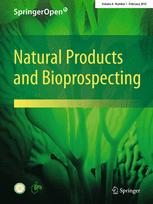|
|
Two Natural ent-kauranoids as Novel Wnt Signaling Inhibitors
Collect
Jing Zhang, Ling-Mei Kong, Rui Zhan, Zhen-Nan Ye, Jian-Xin Pu, Han-Dong Sun, Yan Li
Natural Products and Bioprospecting. 2014, 4 (3): 135-140.
DOI: 10.1007/s13659-014-0016-4
Constitutively active Wnt signaling frequently occurs in most colon cancers. Therefore, inhibitors of Wnt signaling pathway could provide rational therapeutic effects for colorectal malignancy. Within this paper, we identified two inhibitors of Wnt signaling pathway, rabdoternin B and maoecrystal I from a natural ent-kauranoid library by a dualluciferase reporter gene assay. The two compounds inhibited Wnt signaling pathway in a concentration-dependent manner and exhibited selective cytotoxicity toward a number of colon carcinoma cell lines SW480, HCT116, and HT29, with only weak cytotoxicity towards the normal colonic epithelial cell line CCD-841-CoN. Rabdoternin B and maoecrystal I treatment induced G2/M phase arrest efficiently in SW480 cells as revealed by flow cytometry analysis. A further study found that maoecrystal I decreased the expression of Wnt signaling target genes, including c-myc, cyclin D1, survivin and Axin2 in colon cancer cells. Collectively our data suggests that rabdoternin B and maoecrystal I are novel inhibitors of canonical Wnt signaling pathway and may possess potentials for colon cancer therapy.
References |
Related Articles |
Metrics
|
|
|
Evaluation of Various Factors Affecting Bioconversion of L-Tyrosine to L-DOPA by Yeast Yarrowia lipolytica-NCIM 3450 Using Response Surface Methodology
Collect
Swati T. Gurme, Shripad N. Surwase, Sushama A. Patil, Jyoti P. Jadhav
Natural Products and Bioprospecting. 2014, 4 (3): 141-147.
DOI: 10.1007/s13659-014-0017-3
3, 4-Dihydroxy L-phenylalanine(L-DOPA) is considered a potent drug for the treatment of Parkinson disease. Physical and nutritional parameters where optimized by using Yarrowia lipolytica-NCIM 3450 to accomplished the highest production of L-DOPA. Screenings of critical components were completed by using a Plackett-Burman design, while further optimization was carried out using the Box-Behnken design. The optimized factor levels predicted by the model were pH 6.1, 1.659 g L-1 yeast extract, 1.491 g L-1 L-tyrosine and 0.0290 g L-1 CuSO4. The predicted yield of L-DOPA with these levels was 1.319 g L-1, while actual yield obtained was 1.273 g L-1. The statistical analysis revealed that model is significant with F value 19.55 and R2 value 0.9514. This process resulted in a 3.594-fold increase in the yield of LDOPA. L-DOPA was confirmed by HPTLC and HPLC analysis. Thus, Yarrowia lipolytica-NCIM 3450 has potential to be a new source for the production of L-DOPA.
References |
Related Articles |
Metrics
|
|
|
Panaxadiol and Panaxatriol Derivatives as Anti-Hepatitis B Virus Inhibitors
Collect
Hao Chen, Li-Jun Wang, Yun-Bao Ma, Xiao-Yan Huang, Chang-An Geng, Xue-Mei Zhang, Ji-Jun Chen
Natural Products and Bioprospecting. 2014, 4 (3): 163-174.
DOI: 10.1007/s13659-014-0018-2
28 Derivatives of panaxadiol(PD) and panaxatriol were synthesized and evaluated for their anti-HBV activity on HepG 2.2.15 cells, of which 17 derivatives inhibited HBV DNA replication. Compounds 4, 9, 10, 14, and 15 showed moderate activity against HBV DNA replication with IC50 values ranged from 7.27 to 28.21 μM compared with PD. In particular, 3-O-20-thenoyl panaxadiol(4) inhibited not only HBV DNA replication(IC50=16.5 μM, SI>115.7) but also HBsAg(IC50=30.8 μM, SI>62.0) and HBeAg(IC50=18.2 μM, SI>105.14) secretions. Their structure-activity relationships were discussed for guiding future research toward the discovery of new anti-HBV agents.
References |
Related Articles |
Metrics
|
|
|
Sterols and Terpenoids from Viburnum odoratissimum
Collect
Jun-Zeng Ma, Xing-Wei Yang, Jing-Jing Zhang, Xia Liu, Li-Lan Deng, Xiao-Ling Shen, Gang Xu
Natural Products and Bioprospecting. 2014, 4 (3): 175-180.
DOI: 10.1007/s13659-014-0021-7
A new stigmasterol type natural product, viburodorol A(1), along with eleven known sterols and terpenoids(2-12), were isolated from the aerial parts of Viburnum odoratissimum. The structure of 1 was elucidated on the basis of comprehensive spectroscopic analysis. It's noteworthy that compound 2, the major constituent of this plant, can significantly stimulate glucose absorption in insulin resistant HepG2 cells without affecting cell viability. Furthermore, this compound can also restore the glucose absorption in DXMS-induced insulin resistant 3T3-L1 cells.
References |
Related Articles |
Metrics
|
|
|
Synthesis of L-Ascorbic Acid Lactone Derivatives
Collect
Li-Dong Shao, Ya-Nan Wu, Jun Xu, Juan He, Yu Zhao, Li-Yan Peng, Yan Li, Yu-Rong Yang, Cheng-Feng Xia, Qin-Shi Zhao
Natural Products and Bioprospecting. 2014, 4 (3): 181-188.
DOI: 10.1007/s13659-014-0022-6
A small focused library which comprised of L-AA lactone derivatives was built with a facile method. This reported method was optimized by modifying the acidity of the solvent. As a result, 12 L-AA lactones were synthesized. Among these lactones, lactones 8-12 were new compounds. The cytotoxicity of these synthetic compounds were investigated.
References |
Related Articles |
Metrics
|
|
|
Differential Effect of Artemisinin Against Cancer Cell Lines
Collect
Mounir Tilaoui, Hassan Ait Mouse, Abdeslam Jaafari, Abdelmajid Zyad
Natural Products and Bioprospecting. 2014, 4 (3): 189-196.
DOI: 10.1007/s13659-014-0024-4
The present study aims at defining the differential cytotoxicity effect of artemisinin toward P815(murin mastocytoma) and BSR(kidney adenocarcinoma of hamster) cell lines. Cytotoxicity was measured by the growth inhibition using MTT assay. These in vitro cytotoxicity studies were complemented by the determination of apoptotic DNA fragmentation and Annexin V-streptavidin-FITC assay. Furthermore, we examined the in vitro synergism between artemisinin and the chemotherapeutic drug, vincristin. The in vivo study was investigated using the DBA2/P815(H2d) mouse model. While artemisinin acted on both tumor cell lines, P815 was much more sensitive to this drug than BSR cells, as revealed by the respective IC50 values(12 μM for P815 and 52 μM for BSR cells). On another hand, and interestingly, apoptosis was induced in P815 but not induced in BSR. These data, reveal an interesting differential cytotoxic effect, suggesting the existence of different molecular interactions between artemisinin and the studied cell lines. In vivo, our results clearly showed that the oral administration of artemisinin inhibited solid tumor development. Our study demonstrates that artemisinin caused differential cytotoxic effects depending not only on the concentration and time of exposure but also on the target cells.
References |
Related Articles |
Metrics
|
|

